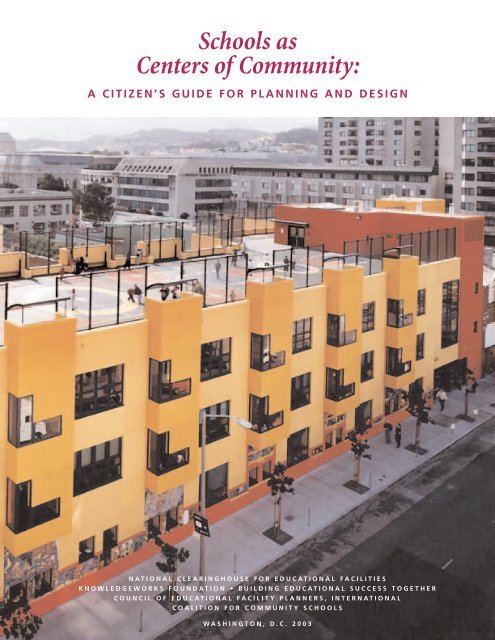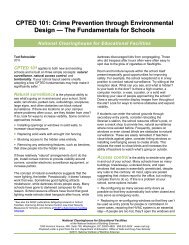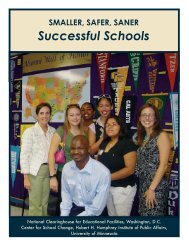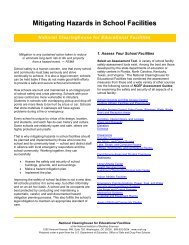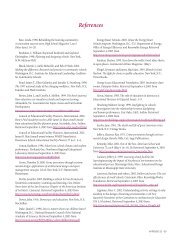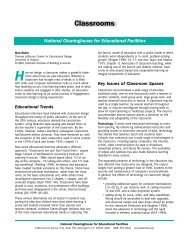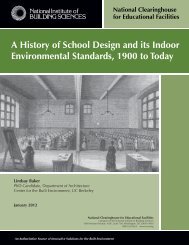Schools as Centers of Community - National Clearinghouse for ...
Schools as Centers of Community - National Clearinghouse for ...
Schools as Centers of Community - National Clearinghouse for ...
You also want an ePaper? Increase the reach of your titles
YUMPU automatically turns print PDFs into web optimized ePapers that Google loves.
<strong>Schools</strong> <strong>as</strong><strong>Centers</strong> <strong>of</strong> <strong>Community</strong>:A CITIZEN’S GUIDE FOR PLANNING AND DESIGNNATIONAL CLEARINGHOUSE FOR EDUCATIONAL FACILITIESKNOWLEDGEWORKS FOUNDATION • BUILDING EDUCATIONAL SUCCESS TOGETHERCOUNCIL OF EDUCATIONAL FACILITY PLANNERS, INTERNATIONALCOALITION FOR COMMUNITY SCHOOLSW ASHINGTON, D.C. 2003
<strong>Schools</strong> <strong>as</strong> <strong>Centers</strong> <strong>of</strong> <strong>Community</strong>:A CITIZEN’S GUIDE FOR PLANNING AND DESIGNSteven Bingler • Linda Quinn• Kevin Sullivan<strong>National</strong> <strong>Clearinghouse</strong> <strong>for</strong> Educational Facilities• KnowledgeWorks FoundationCouncil <strong>of</strong> Educational Facility Planners, International • Building Educational Success Together• Coalition <strong>for</strong> <strong>Community</strong> <strong>Schools</strong>W<strong>as</strong>hington, D.C. • 2003
Publication SponsorsThe <strong>National</strong> <strong>Clearinghouse</strong> <strong>for</strong> Educational Facilities is funded by the U.S. Department <strong>of</strong> Education and providesin<strong>for</strong>mation on planning, designing, funding, building, improving, and maintaining schools. NCEF is affiliated withthe Educational Resources In<strong>for</strong>mation Center (ERIC) system and is managed by the <strong>National</strong> Institute <strong>of</strong> BuildingSciences, a nonpr<strong>of</strong>it organization authorized by Congress to serve <strong>as</strong> an authoritative source <strong>of</strong> in<strong>for</strong>mation on issues<strong>of</strong> building science and technology. www.edfacilities.orgKnowledgeWorks Foundation is Ohio’s largest public education philanthropy. It provides funding and leadership <strong>for</strong>education initiatives throughout the state <strong>as</strong> a means <strong>of</strong> removing barriers to quality education. KnowledgeWorksfocuses on three program are<strong>as</strong>—communities and school facilities, school improvement, and college and careeraccess—and is committed to helping in<strong>for</strong>m public policy <strong>of</strong> educational issues in Ohio and the nation.http://www.kwfdn.orgThe Council <strong>of</strong> Educational Facility Planners, International, w<strong>as</strong> founded in 1921 <strong>as</strong> The <strong>National</strong> Council onSchoolhouse Construction and is the primary advocate and resource <strong>for</strong> planning effective educational facilities.Fostering and disseminating best practices in creative school planning, CEFPI’s sole mission is improving the placeswhere children learn. The Council represents more than 3,000 members in the United States, Canada, Australia, andother nations worldwide. http://www.cefpi.orgBuilding Educational Success Together is a research, constituency-building, and communications initiative seeking tomake better urban school facilities a public priority at the national, state, and local levels. BEST works to secure policychanges that maximize the benefits <strong>of</strong> school facility improvements <strong>for</strong> students, teachers, and neighborhoods. BESTis led by the 21st Century School Fund <strong>of</strong> W<strong>as</strong>hington, D.C., and is supported by the Ford Foundation <strong>as</strong> part <strong>of</strong> thefoundation’s commitment to public education excellence and equity. http://www.21csf.org/csf_home/BEST/best.<strong>as</strong>pThe Coalition <strong>for</strong> <strong>Community</strong> <strong>Schools</strong> is an alliance <strong>of</strong> more than 160 national, state, and local organizations representingcommunity building, education, family support, government, health and mental health, philanthropy, policyadvocacy, school facilities planning, youth development, and national, state, and local community school networks.The mission <strong>of</strong> the coalition is to create a united movement <strong>for</strong> community schools.http://www.communityschools.orgAcknowledgmentsThe publication sponsors extend their appreciation to Steven Bingler <strong>for</strong> his extensive help in revising and updatingthis second edition <strong>of</strong> <strong>Schools</strong> <strong>as</strong> <strong>Centers</strong> <strong>of</strong> <strong>Community</strong>. The sponsors also thank the following contributors andreviewers: Jim Biehle, Marty Blank, William Brenner, Ellen Czeplewski, Barbara Diamond, Fritz Edelstein, LauraEmmett, Randy Fielding, Mary Filardo, Susan Frost, James Gardner, Michael Hamilton, Bobbie Hill, Claudia Kent, TomKube, Judy Marks, Joanne Neft, Jane Quinn, Linda Roberts, Sam Sentelle, Michael Stanton, Geri Unger, Rilla Wiley,John Wingfelder, Rosemary Woodruff, and Roger Yohe.III
Table <strong>of</strong> ContentsPart One. The Challenge . . . . . . . . . . . . . . . . . . . . . . . . . . . . . . . . . . . . . . . . . . . . . . . . . . . . . . . . . . . . . . . . . . .1Part Two. Six Design Principles . . . . . . . . . . . . . . . . . . . . . . . . . . . . . . . . . . . . . . . . . . . . . . . . . . . . . . . . . . . .5Design Principle 1. . . . . . . . . . . . . . . . . . . . . . . . . . . . . . . . . . . . . . . . . . . . . . . . . . . . . . . . . . . . . . . . . . . . . . . . . . .6The learning environment should enhance teaching and learning and accommodate the needs <strong>of</strong> all learners.Design Principle 2. . . . . . . . . . . . . . . . . . . . . . . . . . . . . . . . . . . . . . . . . . . . . . . . . . . . . . . . . . . . . . . . . . . . . . . . . . .8The learning environment should serve <strong>as</strong> a center <strong>of</strong> the community.Design Principle 3. . . . . . . . . . . . . . . . . . . . . . . . . . . . . . . . . . . . . . . . . . . . . . . . . . . . . . . . . . . . . . . . . . . . . . . . . . .9The learning environment should result from a planning and design process that involves all community interests.Design Principle 4. . . . . . . . . . . . . . . . . . . . . . . . . . . . . . . . . . . . . . . . . . . . . . . . . . . . . . . . . . . . . . . . . . . . . . . . . .10The learning environment should provide <strong>for</strong> health, safety, and security.Design Principle 5. . . . . . . . . . . . . . . . . . . . . . . . . . . . . . . . . . . . . . . . . . . . . . . . . . . . . . . . . . . . . . . . . . . . . . . . . .12The learning environment should make effective use <strong>of</strong> available resources.Design Principle 6. . . . . . . . . . . . . . . . . . . . . . . . . . . . . . . . . . . . . . . . . . . . . . . . . . . . . . . . . . . . . . . . . . . . . . . . . .13The learning environment should be flexible and adaptable.Part Three. Design Principles in Action . . . . . . . . . . . . . . . . . . . . . . . . . . . . . . . . . . . . . . . . . . . . . . . . . .15C<strong>as</strong>e Study 1. Gaylord High School, Gaylord, Michigan . . . . . . . . . . . . . . . . . . . . . . . . . . . . . . . . . . . . . . . . . . . .16C<strong>as</strong>e Study 2. PS 5, The Ellen Lurie School, New York, New York . . . . . . . . . . . . . . . . . . . . . . . . . . . . . . . . . . . .18C<strong>as</strong>e Study 3. Center <strong>for</strong> Applied Technology and Career Exploration, Rocky Mount, Virginia . . . . . . . . . . . .20C<strong>as</strong>e Study 4. City Heights K–16 Educational Collaborative, San Diego, Cali<strong>for</strong>nia . . . . . . . . . . . . . . . . . . . . .22C<strong>as</strong>e Study 5. Tenderloin <strong>Community</strong> School, San Francisco, Cali<strong>for</strong>nia . . . . . . . . . . . . . . . . . . . . . . . . . . . . . .24C<strong>as</strong>e Study 6. J. F. Oyster Bilingual Elementary School, W<strong>as</strong>hington, D.C. . . . . . . . . . . . . . . . . . . . . . . . . . . . . .26C<strong>as</strong>e Study 7. Noble High School, North Berwick, Maine . . . . . . . . . . . . . . . . . . . . . . . . . . . . . . . . . . . . . . . . . .28C<strong>as</strong>e Study 8. Crow Island School, Winnetka, Illinois . . . . . . . . . . . . . . . . . . . . . . . . . . . . . . . . . . . . . . . . . . . . .30C<strong>as</strong>e Study 9. Interdistrict Downtown School, Minneapolis, Minnesota . . . . . . . . . . . . . . . . . . . . . . . . . . . . . .32C<strong>as</strong>e Study 10. High Tech High, San Diego, Cali<strong>for</strong>nia . . . . . . . . . . . . . . . . . . . . . . . . . . . . . . . . . . . . . . . . . . . . .34C<strong>as</strong>e Study 11. Henry Ford Academy, Dearborn, Michigan . . . . . . . . . . . . . . . . . . . . . . . . . . . . . . . . . . . . . . . . .36C<strong>as</strong>e Study 12. Met Center, Providence, Rhode Island . . . . . . . . . . . . . . . . . . . . . . . . . . . . . . . . . . . . . . . . . . . . .38C<strong>as</strong>e Study 13. School <strong>of</strong> Environmental Studies, Minneapolis, Minnesota . . . . . . . . . . . . . . . . . . . . . . . . . . . .40IVSCHOOLS AS CENTERS OF COMMUNITY: A CITIZEN’S GUIDE FOR PLANNING AND DESIGN
Part Four. Making it Happen . . . . . . . . . . . . . . . . . . . . . . . . . . . . . . . . . . . . . . . . . . . . . . . . . . . . . . . . . . . . .43Getting Started and Getting Organized . . . . . . . . . . . . . . . . . . . . . . . . . . . . . . . . . . . . . . . . . . . . . . . . . . . . . . .44Step 1. Initiating the Planning Process . . . . . . . . . . . . . . . . . . . . . . . . . . . . . . . . . . . . . . . . . . . . . . . . . . . . . . . . .44Step 2. Funding the Planning Process . . . . . . . . . . . . . . . . . . . . . . . . . . . . . . . . . . . . . . . . . . . . . . . . . . . . . . . . . .45Step 3. Identifying a Facilitator . . . . . . . . . . . . . . . . . . . . . . . . . . . . . . . . . . . . . . . . . . . . . . . . . . . . . . . . . . . . . . .46Step 4. Assembling the Core Planning Team . . . . . . . . . . . . . . . . . . . . . . . . . . . . . . . . . . . . . . . . . . . . . . . . . . . .48Step 5. Organizing the Steering Committee . . . . . . . . . . . . . . . . . . . . . . . . . . . . . . . . . . . . . . . . . . . . . . . . . . . . .48Involving the <strong>Community</strong> . . . . . . . . . . . . . . . . . . . . . . . . . . . . . . . . . . . . . . . . . . . . . . . . . . . . . . . . . . . . . . . . . .50Step 6. Involving Students . . . . . . . . . . . . . . . . . . . . . . . . . . . . . . . . . . . . . . . . . . . . . . . . . . . . . . . . . . . . . . . . . . .50Step 7. Involving Parents . . . . . . . . . . . . . . . . . . . . . . . . . . . . . . . . . . . . . . . . . . . . . . . . . . . . . . . . . . . . . . . . . . . .52Step 8. Involving Educators . . . . . . . . . . . . . . . . . . . . . . . . . . . . . . . . . . . . . . . . . . . . . . . . . . . . . . . . . . . . . . . . . .52Step 9. Involving Business . . . . . . . . . . . . . . . . . . . . . . . . . . . . . . . . . . . . . . . . . . . . . . . . . . . . . . . . . . . . . . . . . . .53Step 10. Involving Senior Citizens . . . . . . . . . . . . . . . . . . . . . . . . . . . . . . . . . . . . . . . . . . . . . . . . . . . . . . . . . . . . .55Step 11. Involving <strong>Community</strong> Organizations and Government Agencies . . . . . . . . . . . . . . . . . . . . . . . . . . . . .55Step 12. Involving the School Board and District Administration . . . . . . . . . . . . . . . . . . . . . . . . . . . . . . . . . . .56Developing and Implementing a M<strong>as</strong>ter Plan . . . . . . . . . . . . . . . . . . . . . . . . . . . . . . . . . . . . . . . . . . . . . . . . .57Step 13. Building Common Understanding, Shared Beliefs, and a Collective Vision . . . . . . . . . . . . . . . . . . . . .58Step 14. Determining Educational Needs . . . . . . . . . . . . . . . . . . . . . . . . . . . . . . . . . . . . . . . . . . . . . . . . . . . . . . .60Step 15. Identifying Resources . . . . . . . . . . . . . . . . . . . . . . . . . . . . . . . . . . . . . . . . . . . . . . . . . . . . . . . . . . . . . . .61Step 16. Developing Recommendations . . . . . . . . . . . . . . . . . . . . . . . . . . . . . . . . . . . . . . . . . . . . . . . . . . . . . . . . .62Step 17. Communicating with the Larger <strong>Community</strong> . . . . . . . . . . . . . . . . . . . . . . . . . . . . . . . . . . . . . . . . . . . .62Step 18. Creating a M<strong>as</strong>ter Plan . . . . . . . . . . . . . . . . . . . . . . . . . . . . . . . . . . . . . . . . . . . . . . . . . . . . . . . . . . . . . . .64Step 19. Implementing the M<strong>as</strong>ter Plan . . . . . . . . . . . . . . . . . . . . . . . . . . . . . . . . . . . . . . . . . . . . . . . . . . . . . . . .65Part Five. Some Final Thoughts . . . . . . . . . . . . . . . . . . . . . . . . . . . . . . . . . . . . . . . . . . . . . . . . . . . . . . . . . .67References . . . . . . . . . . . . . . . . . . . . . . . . . . . . . . . . . . . . . . . . . . . . . . . . . . . . . . . . . . . . . . . . . . . . . . . . . . . . . . . . .69V
Photodisc.VISCHOOLS AS CENTERS OF COMMUNITY: A CITIZEN’S GUIDE FOR PLANNING AND DESIGN


